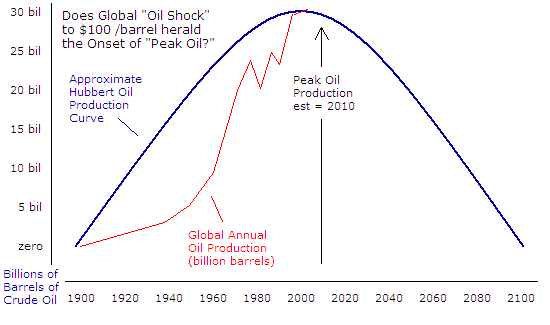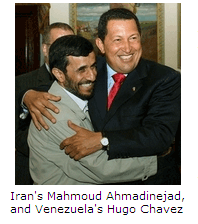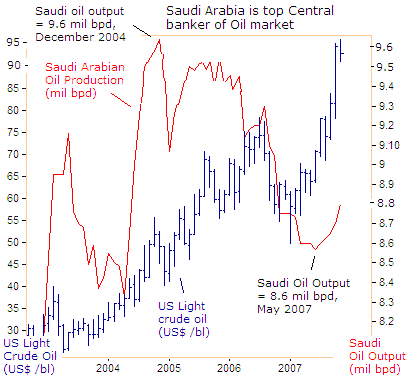|
THURSDAY EDITION January 8th, 2026 |
|
Home :: Archives :: Contact |
 |
Have Global Stock Markets Topped Out on "Peak Oil?"Gary Dorsch, Editor, Global Money TrendsNovember 15, 2007 editor@sirchartsalot.com For the vast majority of Americans who usually don't follow trends in the crude oil futures market, the Global "Oil Shock" only caught their attention after gasoline prices suddenly jumped 25 cents a gallon at the pump this month, and about 80 cents more than a year ago. Last week, West Texas Sweet crude oil surged to an all-time high of $98.62 /barrel, and jolted the Dow Jones Industrials 4% lower towards the 13,000 level, zapping the value of investors' 401k accounts. Guy Caruso, the head of the US Energy Information Administration, told reporters on Nov 12th, "We haven't seen the full pass-through of high oil prices yet. I would say what's in the pipe right now for gasoline is about another 20 cents." The stunning rise in the price of crude oil, up 56% this year and up 365% in a decade, to within a whisker of the magical $100 /barrel level, has some traders wondering whether "Peak Oil" is finally here. If correct, is the spectacular bull-run for global stock markets, which is now 4.5-years old, building a major "rounding top" pattern? Until recently, high and rising oil prices didn't disturb the bullish psychology among global stock market operators. Instead, the spin surrounding rising oil prices described a positive story, an unprecedented boom in the world economy. But historically, Global "Oil Shocks" have tipped the global economy into recession. For example, the Arab oil embargo of 1973-74 and the Iranian Revolution of 1978-79 triggered unprecedented increases in oil prices and were associated with worldwide recessions. Depending on how the adjustment is calculated, $38 a barrel for crude oil in the 1970's would be worth around $96 to $103 /barrel today. Most US recessions in the post-World War II era were preceded by sudden spikes in oil prices.  "Peak Oil" refers to the inevitability of a peak in global oil production. Oil is a finite, non-renewable resource, and once half of the original reserves are depleted, oil production is likely to stop growing and then begin a terminal decline. In 1956, a US geologist M. King Hubbert figured that the rate of global oil production would follow a bell curve. Once "Peak Oil" production has been reached, output begins to decline and oil prices go up. Hubbert estimated that "Peak Oil" would arrive around 2010. OPEC sits on about 75% of the world's total proven oil reserves of 1.21 trillion barrels, according to British Petroleum's annual Review of World Energy. "Global reserves are more than sufficient to meet current production levels for more than 40-years, although accessing the oil is getting tougher due to high exploration and production costs, and reserves are also falling under more state control," BP said. Some of the biggest proven oil reserves lie in Saudi Arabia, with 264.3 billion barrels, and the Canadian oil sands may contain up to 163.5 billion barrels. But other big sources of crude oil are under the control of the "Axis of Oil," namely Iran, Russia, and Venezuela, an informal alliance designed to counter US influence in the Middle East. State-owned oil companies already control three-quarters of the world's crude, dwarfing the holdings of major oil companies like Exxon Mobil and British Pete.  Earlier this year, Venezuela's mercurial Hugo Chávez took control of the heavy oil fields in the Orinoco Belt that may hold up to 235 billion barrels of oil. Chavez stripped the world's biggest oil companies of operational control over massive Orinoco Belt crude projects, which attracted $17 billion in investment by foreign oil companies, more than any other part of the country. Earlier this year, Venezuela's mercurial Hugo Chávez took control of the heavy oil fields in the Orinoco Belt that may hold up to 235 billion barrels of oil. Chavez stripped the world's biggest oil companies of operational control over massive Orinoco Belt crude projects, which attracted $17 billion in investment by foreign oil companies, more than any other part of the country. Venezuela is the fourth-largest supplier of oil to the United States, accounting for more than 10% of American oil imports. Chavez has made several threats to cut off all oil exports to the United States, should the Bush administration attack Iran's nuclear facilities. The OPEC oil cartel, which accounts for 40% of the world's production, is gaining enormous power and wealth. OPEC provides almost half of total US crude oil imports, and is expected to rake in a record $658 billion this year from oil exports and $760 billion next year. Russia's foreign currency reserves have soared to $450 billion this month, even after paying off $125 billion of foreign debt. Iran's Ayatollah Khameini is also the first OPEC leader since Saddam Hussein to demand Euros instead of US dollars, in return for payment of its oil exports, threatening the US dollar's status as the world's reserve currency. On July 19th, Iran asked Japanese refiners to switch to the yen to pay for all crude oil purchases. Russia plans to open the Energy Stock Exchange in St. Petersburg in the first half of next year to trade Urals blend crude oil in rubles. Of the 65 largest oil producing countries in the world, 54 are past their "Peak Oil" production and are now in decline, including the USA, down 11% since 1971, and the UK's North Sea oil reserves are down 27% since peaking in 1999. Other big oil producers (more than 500,000 bpd) that are in decline include Australia, down 26% since 2001, and Norway, down 13% since 2001. The Cantarell oil field, Mexico's largest has also peaked with its output falling to 1.7 million bpd in 2007, down from its peak output of 2.1 million bpd. 
The United States is the world's biggest guzzler of crude oil, consuming 21 million barrels a day, while importing 14 million bpd. But instead of proposing ways for Americans to conserve energy, and reduce their reliance on the foreign imports, the Bush clan is leaning on Saudi Arabia, the central banker of oil, to pump more "black gold", from its dwindling spare capacity of roughly 2-million barrels per day. But on Nov 12th, Saudi Arabia's oil minister Ali al-Naimi said "there will be absolutely no discussion of a production increase by heads of state or their oil ministers on short-term supply" in Riyadh next week. Naimi said that OPEC had nothing to do with the Global "Oil Shock" but is watching the market "very carefully" and did not rule out the possibility of an increase in production at OPEC's December meeting. "I cannot answer why the prices are so high. Prices are influenced by many factors. The demand is not there, and inventory levels are within the 5-year average and in a comfortable place. These pessimists about the adequacy of supply and adequacy of reserves in the future, I think they are doing a lot of damage to the stability on the market," he said, referring to "Peak Oil" theorists. "We are of course concerned about high oil prices," said OPEC chief Mohammed bin Dhaen Al Hamli on Oct 30th. But the market is increasingly driven by forces beyond OPEC's control. It's driven by geopolitical events and the growing influence of financial investors," said Hamli, who is also UAE oil minister. "We have to stay alert. If the market needs more oil, we will supply it," he added. But Riyadh's ability to keep the crude oil market under wraps, by pumping more oil might be drawing to end as early as 2008. The International Energy Agency is forecasting that global demand will climb by 2.1 million bpd to 88 million bpd next year. Global supply however, is forecast to rise a scant 200,000 bpd to 85.6 million bpd, leaving a growing shortfall that would exhaust Saudi's spare capacity. To read the rest of this article, please click on the hyperlink below, http://sirchartsalot.com/article.php?id=73 Gary Dorsch, Editor, Global Money Trends November 15, 2007 editor@sirchartsalot.com To order a subscription to Global Money Trends, click on the hyperlink below, http://www.sirchartsalot.com/newsletters.php or call toll free to order, Sunday thru Thursday, 8 am to 10 pm EST, and Friday 8 am to 5 pm, at 866-553-1007. This article may be re-printed in its entirety on other internet sites for public viewing, with links required to, http://www.sirchartsalot.com/newsletters.php To stay on top of volatile markets, consider a subscription to the Global Money Trends newsletter, which includes a special bonus for new and existing subscribers, - "Audio Broadcasts", posted on Monday and Wednesday evenings, during Asian trading hours, to the Log-In section of our website, with our latest analysis of gold, crude oil, base metals, foreign currencies, interest rates and the top stock markets from around the world. Disclaimer: SirChartsAlot.com's analysis and insights are based upon data gathered by it from various sources believed to be reliable, complete and accurate. However, no guarantee is made by SirChartsAlot.com as to the reliability, completeness and accuracy of the data so analyzed. SirChartsAlot.com is in the business of gathering information, analyzing it and disseminating the analysis for informational and educational purposes only. SirChartsAlot.com attempts to analyze trends, not make recommendations. All statements and expressions are the opinion of SirChartsAlot.com and are not meant to be investment advice or solicitation or recommendation to establish market positions. Our opinions are subject to change without notice. SirChartsAlot.com strongly advises readers to conduct thorough research relevant to decisions and verify facts from various independent sources. Copyright © 2005-2007 SirChartsAlot, Inc. All rights reserved. |
| Home :: Archives :: Contact |
THURSDAY EDITION January 8th, 2026 © 2026 321energy.com |
|